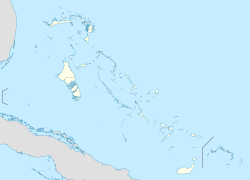Castaway Cay
 |
|
| Location of Castaway Cay in the Bahamas | |
| Geography | |
|---|---|
| Location | Atlantic Ocean |
| Archipelago | Lucayan Archipelago |
| Area | 1,000 acres (400 ha) |
| Administration | |
| Demographics | |
| Population | ≈ 60 |
Castaway Cay is a private island in the Bahamas which serves as an exclusive port for the Disney Cruise Line ships. It is located near Great Abaco Island and was formerly known as Gorda Cay. In 1997, The Walt Disney Company purchased a 99-year land lease for the cay from the Bahamian government, set to expire in 2096, giving the company substantial control over the guest experience on the island.
Castaway Cay was the first private island in the cruise industry where the ship docks alongside so guests do not have to tender to land.
The island is still largely undeveloped, as only 55 of the 1,000 acres (4.0 km2) are being used. Castaway Cay now has approximately 60 Disney Cruise Line permanent residents who keep the island running daily; the numbers fluctuate between the busy season and off season.
Gorda Cay was first settled in 1783. Gorda's airstrip (now Castaway Cay Airport) was once used as a stop in the 1930s for bootleggers then for drug runners.
Gorda Cay had also been used for filming in 1983. The beach where Tom Hanks first encounters Daryl Hannah in Splash is on the island. Part of the film Pirates of the Caribbean: The Curse of the Black Pearl was filmed on the island.
In 1996, the Disney Cruise Line purchased a 99-year lease for Gorda Cay from the Bahamian government, intending the cay as the line's private island, and renamed it Castaway Cay. The company spent $25 million while construction took 18 months This included dredging 50,000 truckloads of sand from the depths of the Atlantic Ocean. The pier and its approaches were constructed to allow the Disney ships to dock alongside, thus removing the need for tenders to get the passengers ashore. To create the mooring site for the ships, workers dredged sand and used explosives to blast coral, and form a 1,700-foot (520 m) channel about 35 feet (11 m) deep and ranging from 200 to 400 feet (120 m) wide.
...
Wikipedia

